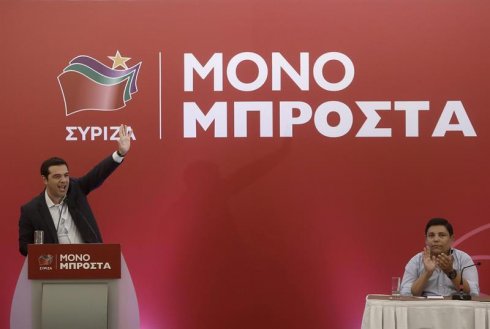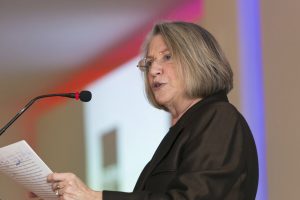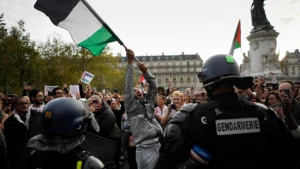Photo credit: La Izquierda Diario
Original article published in La Izquierda Diario on September 2, 2015.
SYRIZA (SY.RIZ.A. – Synaspismós Rizospastikís Aristerás)
Coalition of the Radical Left (“Syriza” in Greek means “from the roots” or “radically”)
Formed as an alliance in 2004, this party is a result of the regrouping of various left tendencies around Synaspismos (Eurocommunists). Since 2013, SYRIZA has operated as a unified party.
SYRIZA obtained 16.8% and 26.9% in the elections of May and June 2012 respectively, a clear rise from the 5.5% won in 2007 and 4.6% in 2009.
Within SYRIZA there were – until a few days ago – two main tendencies. The majority was the Left Unity tendency grouped around Alexis Tsipras, composed of several other smaller groups. The minority tendency was the Left Platform, led by Panagiotis Lafazanis and Antonis Davanellos (who got 30% of the votes in the 2013 Congress). The Left Platform comes from the left wing of Synaspismos.
Within the majority of SYRIZA, the critical “Group of 53” was formed, who sometimes voted with the Left Platform and at other times sided with Tsipras. In the last few days, many of its members have joined Popular Unity, while others have stayed with Tsipras.
Popular Unity
After the capitulation of Tsipras to the Troika, his resignation from the Greek government and his call for new elections, the Left Platform broke off with SYRIZA to create the new reformist party Popular Unity.
Among those behind the formation of this party are 25 of SYRIZA’s former deputies, including economist Kostas Lapavitsas and SYRIZA parliamentary spokesperson Panagiotis Lafazanis.
With this new party, former members of the Left Platform of SYRIZA are looking to “return” to the “real SYRIZA” of earlier years, with an “anti-austerity” profile and a call for an “orderly exit from the Euro”.
Popular Unity announced its intention to run in the next elections, and have added to their electoral lists the former president of the Greek Parliament Zoé Konstantopoulou, other former members of SYRIZA and the groups ARAN and ARAS (who until only days ago were both a part of Antarsya).
Synaspismós (Coalition of the Left, of Movements and Ecology)
Synaspismos was the most important party that gave rise to SYRIZA; its origins were in the Eurocommunist wing of the Greek Communist Party (KKE). In Synaspismos and then SYRIZA were militants who came from various splits from the KKE. Synaspismos started off as a coalition between the KKE and the EAR (Greek Left) in the 1989 general elections. After the KKE decided to participate in government coalitions with New Democracy (June 1989) and then both ND and PASOK (November 1989), the KKE suffered a split in 1991 with an important minority going on to form Synaspismos. Synaspismos then went on to become a political party which the EAR later dissolved into.
KOE (Communist Organization of Greece)
The KOE is of Maoist origins and arises out of a split from the KKE in 1982. Their strategy is to speak of elements of “national” or “patriotic” resistance to austerity. The KOE has lined up with the critical sectors of SYRIZA, and its deputies and members of the SYRIZA Central Committee resigned from SYRIZA after the signing of the third bailout.
DEA (Diethnistikí Ergatikí Aristerá – Internationalist Workers’ Left)
The DEA is a split from the SEK, the sister organization of the British Socialist Workers Party (SWP) in 2001 and has been a member of SYRIZA since its foundation. The DEA was also a part of the Left Platform. In December 2014 they reunited with Kokkino (“Red”, a previous split from DEA). The party has observer status within the United Secretariat of the Fourth International (USFI), which is aligned to the majority of the French NPA and Anticapitalistas (formerly Izquierda Anticapitalista) in Spain. The DEA is also a sister organization to the International Socialist Organization of the United States, another split from traditional tendency of Tony Cliff. The DEA has joined Popular Unity.
Website: http://dea.org.gr
Communist Platform
The Greek section of the International Marxist Tendency led by Alan Woods. They were in SYRIZA in recent years but were not part of the Left Platform. They are currently discussing whether or not to join Popular Unity.
KKE (Communist Party of Greece)
Founded in 1918, the KKE had hundreds of thousands of militants during the Nazi occupation (1941-1944) and led the National Liberation Front (EAM). The KKE went underground during the Civil War and was legalized after the fall of the Colonels’ Regime in 1974. Historically, the KKE has always had a policy of class conciliation.
The party’s coalition with New Democracy in 1989 saw nearly all of the youth of the KKE break away. According to various sources, between ten to fifteen thousand members broke away and formed the New Left Current (NAR – see below).
After this period of crisis, the KKE achieved a relative recovery. The party won 9.5% of the vote in the 2004 elections and 8.5% in 2012, and has representatives in the national Parliament. The KKE has an important influence in some unions in strategic sectors of the economy, such as the shipyards, through its PAME trade union federation. However, they have a strategy of sectarianism and self-proclamation. The KKE neither coordinates with nor even participates in demonstrations such as those called by other trade union bureaucracies, not even those called for the many general strikes that have occurred over the last few years. The party has instead held its own separate rallies, thus blocking any chance of creating a workers’ united front. According to Jacobin magazine, their list got 18.5% of votes in the student elections of 2014.
ANTARSYA (Anticapitalist Left Cooperation for the Overthrow)
(“Antarsia” in Greek means “mutiny”)
ANTARSYA is the main organization of the “far left”. Until recently, parties such as ARAN, ARAS, NAR, SEK and OKDE-Spártakos, along with individual affiliates, were a part of ANTARSYA. ARAN and ARAS have now joined the electoral campaign of Popular Unity.
After the riots of December 2008, two smaller coalitions merged to form ANTARSYA in 2009. It is mainly active in the social movements, the student movement and especially among public and service sector workers. ANTARSYA got 13% of votes in the EAAK student organization elections of 2014. It also has a strong presence in the public sector trade unions and some councilors in local government. In the elections of May 2012, ANTARSYA won 1.2% of the vote, but a month later this fell to 0.33%. In the 2014 European Elections they gained 0.72%. ANTARSYA calls for an exit from the Eurozone and the nationalization of banks and big industries. In the 2015 general elections, they formed the ANTARSYA-MARS electoral coalition with MARS (United Radical Left Front), which includes the Plan B group of Alavanos.
Website: http://antarsya.gr
NAR (New Left Current)
NAR is the biggest organization in ANTARSYA. It comes from a 1989 split of the KKE youth after the party entered coalition government with New Democracy. NAR is ideologically eclectic. It was at the center of ANTARSYA and was divided over which policy to take towards Popular Unity, debating whether to join Popular Unity, propose an electoral alliance with it, or maintain independence. In the latest meeting of the ANTARSYA leadership, the NAR voted to keep an autonomous strategy in the upcoming elections after negotiations with Popular Unity failed, as it did not accept that ANTARSYA keep its name and did not agree with the program.
NAR has a strong presence in the student movement and some well-placed militants in trade unions due to their past in the KKE. Within ANTARSYA they held the balance of power between the right (the Althuserians of ARAN and ARAS) and the left (SEK and OKDE-Spártakos). They have between 1,000 and 1,200 members and affiliates.
Website: http://www.narnet.gr
SEK (Socialist Workers Party)
Formed in 1970 under the name Socialist Revolution Organization, the SEK is one of the left organizations that arose after the fall of the 1974 dictatorship. The SEK is a part of the IST from the tradition of Tony Cliff. Its press is called “Ergatiki Allileggyi” (Workers’ Solidarity). The SEK is the second largest organization in ANTARSYA, with around 400-500 members and has a presence in some public sector trade unions.
Website: http://www.sekonline.gr
ARAN (Left Recomposition)
ARAN was the third largest group within ANTARSYA. They are strongly influenced by the theories of Althusser, Poulantzas and Gramsci. ARAN was part of the right wing of ANTARSYA. Most of this group has decided to join the electoral campaign of Popular Unity.
ARAS (Left Anticapitalist Group) and AS (Left Group)
ARAS and AS are the two smallest groups within ANTARSYA. Just like ARAN, both come from the student movement of the 1980s and are theoretically influenced by Althusser.
After the ANTARSYA national convention in August 30, all of ARAS and most of ARAN left ANTARSYA to join Popular Unity.
OKDE-Spártakos (Organization of Communist Internationalists of Greece – Spartacus)
OKDE-Spártakos is the Greek section of the USFI and is part of a left opposition to the USFI international leadership. They are a part of the ANTARSYA coalition and have over 100 militants in the student and workers’ movement.
Website: http://www.okde.org/index.php/en/
OTHER LEFT GROUPS OUTSIDE OF SYRIZA AND ANTARSYA:
Plan B
Plan B is a group led by Alekos Alavanos, the former president of SYRIZA before Tsipras. Plan B’s strategy is centered on a break with the EU as a starting point for any progressive measure, along with a perspective of left sovereignty.
Xekinima (Socialist Internationalist Organization)
Xekinima (“Beginning”) is the Greek section of the Committee for a Workers International (CWI) led by Peter Taaffe. They started as an entrist group within PASOK in the 1970s until they were expelled in the late 1980s. Xekinima was in SYRIZA from 2007 to 2011. Xekinima leader Andreas Pagiatsos signed the August 13 call for the creation of the NO committees, which was the basis for the creation of Popular Unity. [Neo Xekinima (“New Beginning”) was the name of a left oppositionist journal launched by Pantelis Pouliopoulos, the founder of Greek Trotskyism].
OKDE-EP
(Organization of Communist Internationalists of Greece – Ergatiki Pali [Workers’ Struggle]).
The OKDE-EP split from the OKDE-Spartakós in the 1980s. Until 2005 it considered itself a sympathizing section of the USFI, but has currently turned to a more national view. The name OKDE-EP comes from the name of their newspaper “Ergatiki Pali” (Workers’ Struggle).
Website: http://www.okde.gr
EEK (Workers Revolutionary Party)
The EEK was a part of the Gerry Healy current (the International Committee of the Fourth International – ICFI) during the 1970s and 1980s, and is led by Savvas Matsas. The EEK is a part of the Coordinating Committee for the Refoundation of the Fourth International (CRFI). However, this international tendency has not held international meetings for years and the main CRFI section, the Partido Obrero (PO – Workers’ Party) in Argentina has had major differences with the EEK, such as the PO’s 2012 call to vote for SYRIZA.
Student Movement
EAAK (United Independent Left Movement)
The EAAK is active within the universities and comes from the massive high school and university student movement of the winter of 1990-91. It regroups many anti-capitalist tendencies within the universities. According to a conversation between Sebastien Budgen with Panagiotis Sotiris published in Jacobin, the EAAK has been the main force within the Greek student movement over the last 15 years.
Translated by Óscar Fernández










